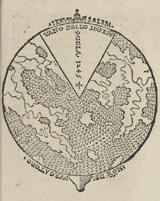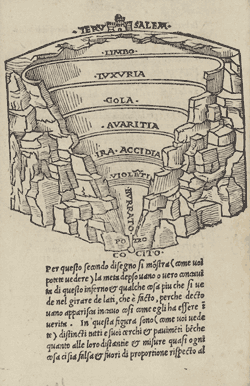|
|
The geography of hell |

|
"... but who art thou
That hast inquir'd of us?" To whom my guide:
"One that descend with this man, who yet lives,
From rock to rock, and show him hell's abyss."
(Inferno XXIX, 89–92, trans. Cary))
|
Map of the earth, showing Hell and Mount Purgatory.
Commedia di Dante insieme con uno dialogo circa el
sito, forma et misure dello Inferno (Florence: Filippo
Giunta, 1506). LA(22) [this image not on display]
|
|
|
For Dante, Hell was a real place, located inside the earth beneath Jerusalem.
It was cone-shaped, made up of a vestibule housing the cowardly and nine layered
concentric circles representing nine levels of sin, whose circumference and depth
could be measured. Dante's journey takes place both in space and time: he enters Hell
on Good Friday and reemerges at the foot of Mount Purgatory early on Easter Sunday
morning, having travelled through the centre of the earth and come out the other side.
The fashion for measuring and mapping out Hell captivated Renaissance commentators.
The study of Dante's cosmology began with the Florentine mathematician and architect
Antonio Manetti (1423–1497). His work was developed by later writers, and most notably
contradicted by the Sienese scholar Alessandro Vellutello in his Dante edition of 1544.
During the winter of 1588, the young Galileo delivered two lectures in Florence on the
topography of Dante's Hell, and judged in favour of Manetti.
|
.gif)
|
|

|
|
Frontispiece of Hell (Venice: Pietro da Fino, 1568). LA(52)
|
|
The circles of Hell. Commedia di Dante insieme con uno dialogo circa el sito,
forma et misure dello Inferno (Florence: Filippo Giunta, 1506). LA(22)
[this image not on display]
|
| |
|
|